Unit Loads - Containers
from the 1830's to the 1970's
The idea behind the 'unit load' is to put an entire shipment into
standard boxes or containers and where necessary to provide specialised
handling equipment for these boxes. Technically a cardboard carton of tin cans
is a unit load, the equipment required to move it being a pair of hands. Hands
are however expensive, particularly when large volumes of low value material
had to be moved. The larger the unit loads the greater the reduction in
handling time for a given quantity of cargo. To make economic sense any
container system has to be widely adopted, prior to the 1930's this meant that
the majority of containers used were for bulk flows of minerals. Things then
began to change as road transport improved and the road-rail container became
increasingly important. In the 1960's the use of the ISO container for
international shipping provoked another major change and influenced the
development of railway services, notably in the use of Freightliner services.
Overview - 1830-2003
Containers of various kinds were in
regular use on the canals from the 1780's and wooden containers were adopted by
the Liverpool & Manchester line in the 1830's for both coal and
general goods (as described in the Historical Background section). These coal
containers were built because of the way the mine was worked but in 1841 Brunel
introduced iron mineral containers in south Wales. These were provided so the
rather friable (easily broken) coal from the mines served by the Vale of Neath
Railway could be transported to Swansea docks. At the docks they were lowered
into the hold of the ship before being emptied via a bottom door, reducing the
distance the coal had to fall. The boxes were about eight feet long but about
four and a half feet wide and were carried four to a wagon. Similar boxes were
used at several other locations, two companies around Wigan used iron coal
containers of the general Brunel type.
Containerisation requires
standardisation to work and for many years only minerals provided a
sufficiently regular trade to support the required investment. The railways
themselves were reluctant to invest in containerisation. The Liverpool &
Manchester Railway built open frame 'skeliton (sic) wagons' to carry
rectangular bottom-door coal containers already in use of the canals but used
their standard flat wagons to carry Pickfords general goods containers.
Most of the mineral containers were simply rather large rectangular
buckets made of either iron or wood and although many travelled on specially
built wagons a lot were carried in three and four plank standard open wagons.
Each railway wagon could carry (typically) three or four oblong containers
arranged along the wagon or six square shaped containers in two rows of three.
During the pre grouping era the Great Eastern Railway operated a
container service for the luggage of passengers sailing to Europe via Harwich.
The containers were roughly square in section made of planks with timber
outside framing, they were painted light 'freight grey' with G E on the side in
white. The South East & Chatham Railway also operated a luggage container
service for passengers heading for the continent but I have not been able to
trace the details of the containers used.
By about 1900 road furniture vans were fitted with removable wheels so they could be moved on standard railway wagons, these evolved into covered furniture containers
by the time of the First World War. Building on the work done by
the pre grouping (pre 1923) companies railway container designs were
standardised during the later 1920's. The new RCH approved standard containers
were based on the existing designs of the time. This move was mainly lead by
the LMS who began promoting containers in 1928 in order to counter the
competition from road haulage companies for door-to-door services. I believe
the earliest railway company door-to-door container services started in about
1926 but I cannot confirm the details.
By the 1930's the container had
proved its worth for furniture removals work and was also popular for the
transport of higher value cargo. One of the big successes for the railway
container was the shipment of meat and although the railways continued to build
vans for the carriage of meat the containers dominated this trade from the mid
1930's onward. The LNER only used meat containers for this trade after 1935,
and several of these might be included in a fast express goods train rake.
British fresh meat was shipped mainly from Scotland hanging on hooks in
ventilated containers. Imported frozen meat was carried from the docks in
refrigerated and insulated containers.
British railways built many
thousands of containers, mainly to the standard pre-war 'van' type designs. Up
to the 1960's it was usual to send containers through the system as single
loads, hauled in standard mixed goods trains but under British Railways that
all-container 'liner' services began to emerge in the late 1950's.
Probably the first example of a nominally all-container train service
was the BR/London Midland Region 'Condor' (container-door-to-door) service.
Condor used the existing pre-war container designs on standard container wagons
and with a few specially modified long wheelbase wagons as well (sketch shown
below). Condor operated as a fixed 'liner' service between London and Glasgow.
There were continuing experiments to find ways of reducing
the handling time and manpower required for loading and unloading containers
from railway wagons. Many of these experiments employed novel lifting and
securing arrangements, one example was the 'light alloy Type A container' used
for McVitie & Price biscuit traffic from about 1961 until (I believe) the
early 1970's. These used steel pins on the wagon which engaged with sockets in
the corners of the underside of the container and they had no lifting rings on
the roof but employed a pallet type base allowing them to be moved using a
(big) fork lift truck. The containers had smooth sides and a slight camber to
the roof. One end was smooth, the other was fitted with a small door. On the
railway wagon they were carried with the door ends facing each other. Ten
vacuum fitted ten foot wheelbase railway wagons were converted for this
traffic, each to carry two of the containers, and as they were basically a
chassis with three transverse steel bars (to which the corner securing pins for
the containers were fitted) modelling a loaded example is not that difficult.
Unfortunately I do not know what the base colour for the containers was or how
they operated but I believe they ran between London and Scotland. See also
Railway Company Goods Facilities - Container handling for details of the cranes
and other equipment used for containers and a sketch of the McVitie & Price
container lorry.
The BR/LMR Condor service was a success and BR/LMR
followed it with their 'Speedfreight' service, initially operating between Manchester and London, then expanded to other yards around the country. Speedfreight employed a new quick securing system similar to that on the McVities wagons
to reduce loading time for containers. Later Condor services included
Speedfreight containers and their wagons. Some bogie flats were also modified for
both Condor and Speedfreight services. Speedfreight containers were lifted
on and off the wagons using a crane equipped with long drop down arms that
engaged in lifting points on the base of the container, eliminating the need
for someone to climb on top to attach lifting chains.
In the later
1950's specialised containers were developed for transporting bulk
materials such as cement, dolomite, coal and potash. These new designs were
carried on purpose built wagons using conventional British four wheeled wagon
chassis.
The introduction of the ISO container and its widespread
acceptance for international shipping meant they offered cost advantages over
the traditional designs developed by the British railway companies. The ISO
containers, originally eight foot high and eight foot wide were built in
multiples of ten foot lengths. The eight by eight end profile placed them
outside the limits of the British loading gauge and in the mid 1960's
specially built rolling stock was developed to carry them. This resulted in the
setting up of Freightliners as a separate business to handle these containers.
Freightliners services and their containers are discussed in detail in the
section on Freight Operations - Air Braked Freightliner Container Services.
By the 1980's specialised container services were under
development for a wide range of cargo. These employ non ISO containers but
these are fitted with standard ISO lifting and securing points so they can be
dealt with using readily available container handling equipment (see also
Railway Company Goods Facilities - Container handling).
Early Container Design
Most railway containers were
originally built up in a similar way to standard wagon and van bodies; planks
on a wooden frame, often with the framing on the outside to give a smooth
interior. Metal mineral containers date back to the 1830's but from the early
1930's development was much more rapid with experimental designs built in a
wide range of materials including smooth and ribbed pressed steel and plywood.
On the non-minerals trades both closed (van type) and open (wagon type)
containers were used, the latter were never really popular however. As long ago
as the 1830's various designs of open wooden or iron containers for carrying
minerals were used, mainly for coal. The top illustration in the sketch
below is based on a photograph of the East Lancashire Railway's yard at
Preston dated about 1860. The picture was published in a book on the railways
of Preston courtesy of the Harris Museum. It shows simple wooden skips loaded
into one-plank wagons, one of the wagons has only two containers loaded, one at
either end. The interior of the empty wagons in the same photograph appears to
be smooth with no baulks for holding the skips in place but the side planks
appear to be about three or four inches thick. Apparently similar wagons in the
same photograph were carrying general goods. Also shown are a steel GWR mineral
container, used for stone and coal, dating from about 1930 and a pre-grouping
Midland Railway bunker coal wagon, used for delivering coal in the wooden boxes
to its ships at the docks. The LMS later used the Midland containers and wagons
for shipping crushed stone from Rhylstone and Embsay quarries in the Yorkshire
Dales.
Fig ___ Pre-Nationalisation Mineral containers 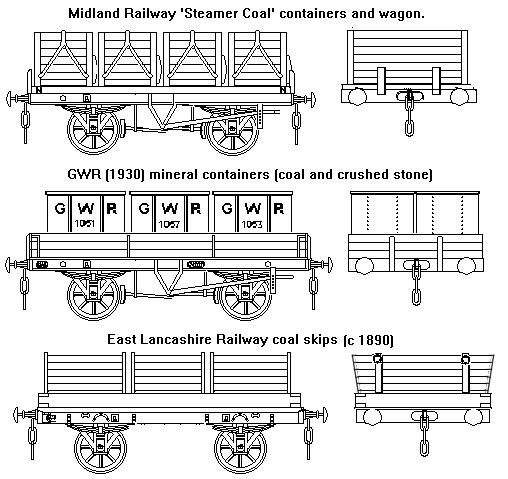
Containers resembling crane grabs were produced for removing
spoil and earth (at least by the GWR), these were generally shipped in standard
open wagons and would be lifted out by crane at the disposal site and
unfastened to discharge them.
By the time of the First World War
'furniture containers' were in use, transported in standard (usually one plank)
wagons. There is a photo dated 1916 in G. F. Chadwick's book on North Staffs
Railway Wagons showing two such containers. The containers had horizontal or
diagonal side planking and the same diagonal lifting straps as seen on the Peco
model.
By the early 1930's McVitie & Price, the Scottish biscuit
makers, were using an outside-framed wooden box about four foot wide, five foot
long and five foot high which had lifting lugs at the top so it could be lifted
on and off railway and road vehicles by a crane. Four of these boxes could fit
in a standard open wagon (although they usually went singly) but they required
a tarpaulin cover when in transit.
The popularity of the more general
purpose, railway owned, containers began in the 1920's and quite rapidly a
degree of standardisation was achieved on the basic sizes and the method of
securing them to a wagon. This enabled the boxes to travel on another companies
wagon if required. Purpose built container wagons for these standard sized
containers were introduced in the 1930's, the first GWR Conflat (as per the
Peco ten foot wheel base model) was built in 1931.
Closed or 'van' type
containers were the most common. They were used for high value cargoes such as
gramophones, carpets, confectionery, baths, pianos, tinned goods, plants and
shrubs. Closed containers were all between 6' 6" to 7' 6" high and they were
built in two basic floor sizes, short and long, both 7' 7 1/2" wide with the
smaller types being 6' 11" long and larger being 16' 5" long.
The short
closed container was called the Type A and the long version Type B. There was a
second letter added to the container prefix which indicated the specific type,
for example the BK is a furniture container and BC is for bicycles (both
offered by Peco). Fleetline offer white metal models of the plain A type and
the insulated AF type.
The most common type of closed container was the
BD, illustrated below, which had side doors as well as an end door and so could
be loaded from a loading dock whilst still on its wagon. This basic design was
in production from the early 1930's right up to 1958.
Variants on the
BD included the BM, a ventilated design for meat traffic fitted with hooks
inside and distinguished externally by it's livery and by small ventilation
panels to either side of the side doors and on the ends.
Chilled meat
and other perishables were shipped in FM type refrigerated containers.
Basically similar to the BD but sometimes slightly smaller and sometimes
lacking the end door, they were usually distinguished by colour, the details
will be found in the section on liveries.
Both the furniture carrying
BK and the bicycle container type BC were fitted with end doors only. The
difference between these was simply the provision in the BC of racks for 78
bikes. Prior to the introduction of these containers bikes were shipped in
metal frames, stacked two rows high, in ordinary open wagons, these were then
covered with a tarpaulin before shipping.
The British Railways designs
resembled the LMS standard planked containers but British Railways added
diagonal strapping to the doors, similar to that on the doors of the Hornby
Minitrix or Lima BR Ventilated Vans.
Fig ___ Standard closed
containers
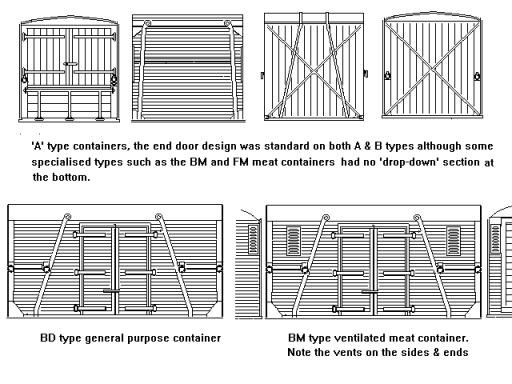
The container supplied by Peco is a furniture container (Type
BK) and dates from 1933. These were less common in general traffic than the BD
type with side as well as end doors. The raised panel in the upper corner of
the Peco body side was provided for traders self adhesive labels.
Parkwood Models have now released a kit comprising a Type A and a Type
B container which can be used on a Peco conflat or on a 'converted' wagon such
as the P D Marsh 1 plank open. The
Peco short wheelbase bolster wagon can be modified to represent an ex LMS 1 plank container wagon and if the container is to be permanently fixed the standard Peco chassis can be easily modified to represent the LMS open-framed container wagon.
Containers were built in both wood and steel, rare examples of steel
types date back as far as the 1920's but steel did not catch on until the mid
to late 1930's. Most containers were built from wooden planks, the steel types could have either smooth sides or pressed-metal sides with ribs or bulges formed into the steel for strength. Vulcanised fibre, the kind of material used for the old fashioned rectangular suitcase, was tried in the early 1930's but plywood was used for containers only from the late 1930's.
The 'Big Four' standard planked wooden containers remained the most common up
to the 1970's but there were variations using different materials and construction methods, some privately owned containers were distinctly different, the example shown below has recessed panels suggesting an 'outside framed' construction. The container was sketched from a photo but I am not sure of the date, the lack of standard securing rings suggests it may well pre-date the introduction of standard flat wagons for containers in the early 1930s.
Fig ___ Lyons Tea 'outside-framed' closed container
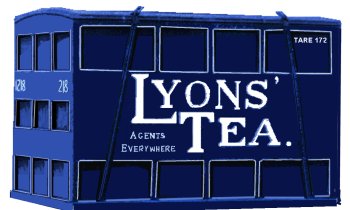
Standard planked containers can be built using 1mm scribed card from Slaters,
although the end doors on type A or B boxes take a little fettling, but plain
sided steel or plywood containers can be knocked up quite easily from postcard.
If you make a mess of a container you can always assume there was a leak in the
roof and cover it with a tarpaulin.
Fig ___ Tarpaulin draped over a
leaky container in British Railways days
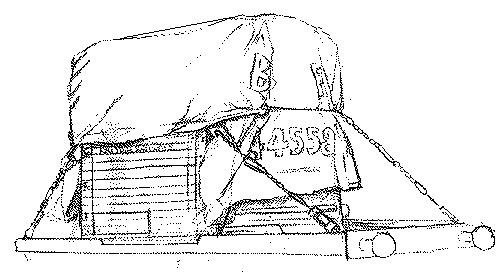
Also produced were a range of open containers, resembling open
bodied wagons with bracing bars across the top (coded C or D). The C and larger
D types had roughly the same floor size as the closed A and B containers
respectively and these open types were carried on the same wagons as the van
types boxes. Open containers were mainly used for building materials,
principally fragile items such as earthenware drain and sewer pipes.
Some were used for transporting cast iron baths from the foundry to the
enamelling factory, which was not railway served. They were collected at the
local goods yard by horse drawn or motor lorries. The C size were generally of
5-plank construction, but if using scribed card for this make them 6 'planks'
high and sand/carve the bottom plank down. The standard D types had doors in
each side and a drop-down end and were commonly 5 plank, and again if using
scribed card I would recommend using 6 'planks' and reducing the thickness of
the bottom plank.
There were variations, in pre British Railways days
there were C's built with low sides (as low as two foot high), used for heavy
materials such as Portland stone, and D's were built with 5 as well as 6 plank
bodies. The DX had all four sides hinged along the bottom edge, secured with
three large clips on each corner. The sides were six planks high, so start with
a seven plank side and reduce the bottom plank as above.
Both the C and
D types and their variants used removable reinforcing timbers across the top,
fitted with an arched metal bracket (to support a tarpaulin). These are the
only tricky bit to model but adding the tarpaulin is one option to get round
this problem. Ropes were often looped over the body of the container and tided
to the lifting/securing rings to keep the contents in place. The C and D type
containers were never terribly popular and their popularity waned further after
the Second World War. Production stopped in 1954 and by the early 1960's most
of the existing stock was out of service.
There was a further standard
type, coded H which was only four foot wide by seven foot long, four of these
would fit on a standard conflat wagon but they generally travelled in normal
open wagons. The H containers were three planks high but the planks were about
eight inches wide giving an over all height of about two feet. They had two
timber 'runners' underneath, with metal side straps. The lifting loops were
attached to the top of the metal side strips. Some of the H containers had an
open top and one end hinged to drop down, others had lids to form a flat top.
The H type containers were commonly used for 'building materials', roofing
tiles, china ware and the like, the H being taken as an abbreviation for 'hod'.
One option when modelling the covered H type is to make the basic body from two
lengths of 4mm square balsa strip, available from model shops, adding detail
with postcard.
Fig ___ Standard open containers
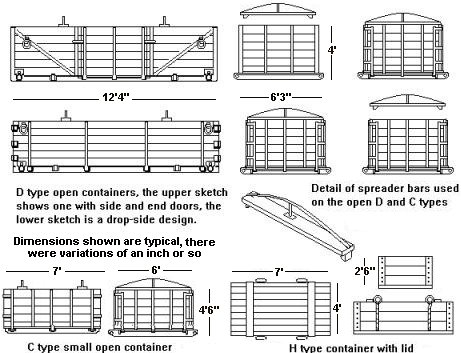
The SR had a rather distinctive non standard insulated
container, with diagonal planked sides, used to carry frozen meat. These
Southern Railway `F' type containers were shorter than a B but longer than an A
and the design was peculiar to the SR. They were carried on specially converted
long wheel base open carriage truck wagons which retained their 'RUCK' coding.
This type is not currently available commercially but could be made up using
scribed card or plasticard and using a Peco example to copy the end shape. The
container is shown in the section on liveries and the wagon is described in the
section on Kit Bashing.
Fish also requires rapid shipment from the
ports to the fish markets and there were some experiments with transporting
live fish in tanks of water. A standard design evolved for these tank
containers, the Midland Railway built some in the 1880's, the Great Northern was moving them on purpose built dual-braked wagons by the 1890's and the Great Central
Railway did not build any fish vans, relying instead on these containers. The MR built
special wagons with a low 'ladder' side, the GNR wagons were of rather more simple construction (at least from a modelling point of view, see Freight Operations - - Non Passenger Coaching Stock - Introduction, Fish & Newspapers for a sketch) and the GCR used standard one
plank wagons. The GN wagons and tanks remained in use into the later 1920's, possibly the early 30's. According to Mr. Essery in his book on Midland Railway Goods
Wagons these containers were phased out by 1914 and I have seen no references
to the LMS using such containers but the GWR used (perhaps experimentally) what
appeared to be the same design, although not for live fish. There is a
photograph dating from the 1930's of such a container being loaded with fish
and ice in Janet Russels book on GWR Company Servants. The containers had a
heavy outside frame and a top comprising two pairs of heavy flap type lids. The
GWR used standard container carrying 'Conflat' wagons for these fish containers
and the wagons were apparently marked as being reserved for this traffic to
avoid any possibility of a wagon not being available. To model this wagon a
Peco container wagon could be fitted with raised vacuum brake connections
(fitted to allow coupling to passenger stock).
Fig ___ Live fish
containers
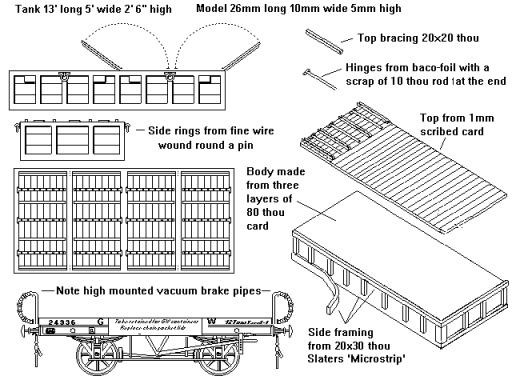
The LMS used a collapsible wooden container for fish traffic,
but I believe these travelled inside vans.
The LMS was at the forefront
of the containerisation movement, initially they modified standard three plank
open wagons to carry them by fitting them with securing points on the upper
sides. From the later 1920's all the Big Four companies and British Railways
produced special wagons for carrying containers. A lot of these wagons were
conversions based on redundant underframes, as cattle traffic was falling
vacuum fitted cattle wagons were converted and with the shift to six wheeled
milk tank wagons the old four wheeled chassis (which were owned by the railway
company) were also switched to container duties. Container flat wagons were
equipped with chains and `bottle screw' or turnbuckle tensioning devices to
hold the load. When not in use the chains sat in pockets or troughs along the
sides of the vehicle.
The Southern Railway was a little different in this respect, they used wagons for containers based on open carriage trucks and these were not equipped with the securing chains and bottle-screws used by the other companies. Southern practice was to secure the container with rope, a cheaper but more time consuming approach. The Southern container flats were also widely used for moving road vehicles, some were even used for ferry traffic to the Continent (see also Railway Freight Operations - Road Vehicles, Military Traffic and Farm Machinery).
The standard container carrying vehicles could
carry two Type A containers or a single type B, but note that if a single A
type is loaded on a wagon it is always placed centrally so as to maintain the
balance of the vehicle. The Southern Railway built a number of contains it classes as 'B' but which were in fact rather shorter than the RCH standard design, these had the securing loops and could be carried on other companies wagons but whereas a standard B type container required only ropes from the end rings to the buffers for securing the smaller types required rather a lot of roping down (full details of the SR containers and associated wagons will be found in the long awaited and recently published SR Wagons Vol.4, see bibliography).
Fig ___ Containers on container wagons
showing securing methods
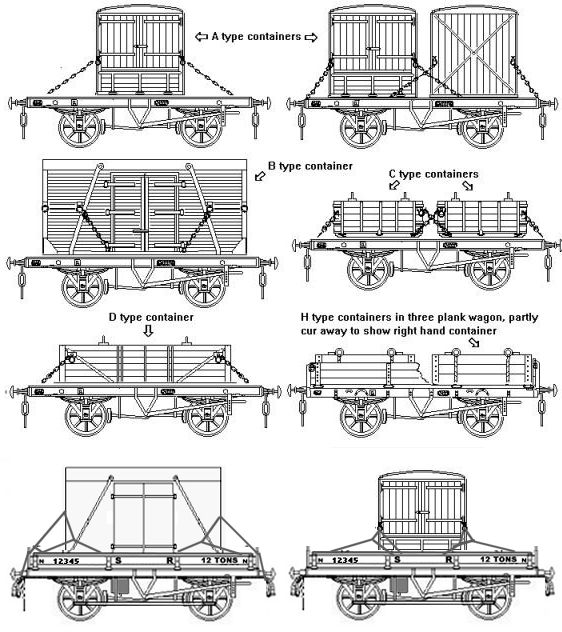
Although the various companies agreed on standard designs of
container, to a common RCH specification, the wagons they used were a
distinctly varied selection. The Peco Conflat wagon is a GWR standard design,
later adopted by BR. The standard purpose built LMS container flat was a
floor-less chassis with corner plates and pockets for the securing chains
added. You can knock up an LMS type loaded with a 'B' type container or two 'A'
containers by using a Peco ten foot wheelbase steel chassis kit. Simply add
side drop-down 'foot plates' and container locating plates from plastic or
paper card. The container(s) will have to have holes cut in the bottom to clear
the coupling blocks on the Peco chassis. Details of building some alternative
container flat wagons will be found in the section on Kit Bashing.
Although being able to remove a container from a wagon is an attractive
idea I found I rarely bothered to do this in practice and now I add container
fastening chains and bottle screws made from bent up wire. On some these lie
alongside the container, which remains removable, on others they lead clear of
the ends of the container down to the wagon, and on these the whole assembly is
glued in place.
Adding the securing chains improves the look of the thing,
in the models shown below the A type has its chains secured to the outer
securing points and is not removable. The insulated F type container, a cut
down Peco kit, has chains glued to the sides as though attached to the inner
securing points and this container is removable.
Fig___ Models of
containers showing securing chains

There were
never quite enough special wagons available for containers and they often ended
up being moved in low sided open wagons, tied in with ropes. The 1 plank and 3
plank types were preferable for this traffic as the crane had to lift the
container over the sides of the wagon. As noted above some of these wagons were
modified for the work, with attachment points along the top of the sides for
container securing chains. On unmodified wagons the ropes would be attached to
the tarpaulin hooks provided on the chassis, but they were also regularly
looped over the buffers on the wagon.
Fig ___ Two 'A' type
containers roped into a three plank wagon
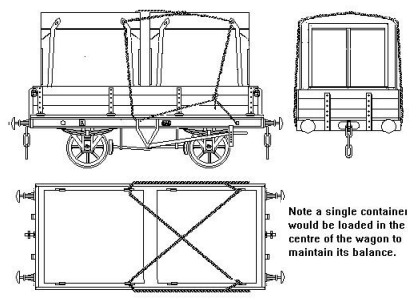
Under BR single B type containers were sometimes carried in high sided
(5 plank or the steel equivalent) open wagons. The fit was a close one so the
doors could not be opened in transit (preventing pilfering) and they did not
need to be roped down. The problems came when the wagon arrived at a goods yard
with only a standard size hand crane as these cranes were not tall enough to
lift the container over the sides of the wagon, which had to be sent on to a
better equipped station where the box could be transferred onto a more suitable
wagon and sent back.
There were also a number of unusual container wagons, the
photograph shows a model of a carriage truck (coded RUCK) designed by the LSWR
to carry horse drawn van bodies minus their wheels for the meat traffic from
the docks to London (where the wheels were re-fitted for local deliveries).
These wagons were later used by the SR for pairs of (smaller than standard)
meat containers and a few survived into the early years of BR when they were
pressed into service carrying (typically) a single B container sitting in the
centre of the wagon. The model shown has not yet had securing chains added to
the container, which is a Peco model.

In the 1940's a few road tanks equipped for transportation on
railway wagons and de-mountable tank containers were built for beer by the LMS
and GWR, but it was under British Railways that considerable numbers of
specialised container types, including de-mountable tanks, were produced.
Similarly there were a few road tank transporter wagons built by the Big Four,
notably for collecting milk from outlying creameries but also some for chemical
traffic. These had to be fitted with RCH approved securing rings so they could
be chained down onto the railway wagon. BR built further examples of these
tanks and used them for a range of traffics.
Early British Railways
Containers
The pre-war RCH standard type wooden bodied containers
as offered by Peco (type BK) and more recently Parkwood Models (who offer a
rather handy twin pack of a Type A and a side-and-end door Type BD) were still
in use into the early 1970's. These pre-war container designs were used for the
`Condor' container door to door service of London Midland region, introduced in
1959 running between London (Hendon) and Glasgow and usually drawn by the
splendidly ugly Metro-Vic co-bo diesels. A number of vacuum braked `plate'
wagons were modified for this particular service, carrying one B type container
and one smaller A type on an open framed chassis with no floor. These wagons
were coded 'Conflat P'. Conflat A's were also used and occasional non-container
wagons and tanks were seen in the rakes as well.
Fig ___ Loaded
Conflat P for the Condor service
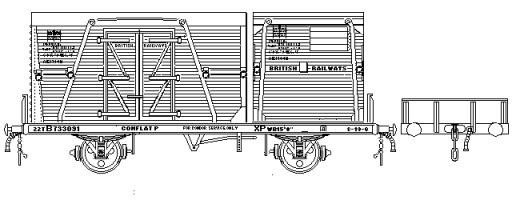
Experiments continued
with different container types, using materials such as fibreglass or moulded
plastic in place of the traditional pressed steel, plywood or wood planking.
One easy to model type was an experimental B type container with a fibreglass
body and roller-shutter doors in the sides. Unfortunately I am not sure how
many were built or what traffic they were used for.
An unusual type
was produced was the AFP (A means the smaller size closed container design, F
signifies insulated for frozen cargo, and P indicates it is designed to carry
palletised loads). These were produced in both sheet metal and moulded plastic
versions and were equipped with dry ice (frozen carbon dioxide) bunkers to keep
the cargo cold in transit. An early adopter was Birds Eye frozen foods who
began operating them in their own livery in about 1961. BR also used these
containers painted in their standard pale blue with black markings 'insulated'
container livery and in the late 1960's some former Birds Eye boxes appeared in
the (much easier to replicate) Macfisheries livery.
They were carried
in pairs on a fleet of fifty twelve foot wheelbase 'Conflat B' wagons
(converted from pipe wagons), to which they were attached using the standard
bottle-screws and chains, and transferred to road semi-trailers for delivery
using standard RCH type roof mounted lifting rings. There were also some
fifteen foot wheelbase flat wagons converted for this traffic (I am not sure of
the origin or exact dimensions of these wagons), coded Conflat I they lacked
the chain pockets on the central sides and were marked 'For use with AFP pallet
containers only'. The longer body meant there was a clear area at each end
(about eighteen inches) and a central gap (about two feet) between the
containers.
I believe the AFP containers were not standard A size
boxes, given that two of them were a snug fit on a twenty one foot long chassis
I think they were actually about nine to ten feet long.
Another unusual
but colourful design was the light alloy (sheet metal) container used by
McVittie & Price (biscuits). These had no roof lifting points at all, and
hence no diagonal straps on the sides, but had a base designed to be lifted
using a fork-lift truck. They employed a new method of securing the container
to the railway wagon using four steel pins which engaged with sockets in the
corners on the underside of the container base. I believe this may have
preceded a similar securing method used for the Speedfreight service as
described below that used rather more elaborate cone shaped pins. The earliest
photograph I have seen is in Don Rowlands book on BR Wagons (see Bibliography)
which is dated 1961. These containers had a door on one side only and in
traffic they moved in pairs on a ten foot wheelbase chassis with the doors
facing each other. As only five wagons were built for these containers they
must have operated in general goods trains or possibly in specific
container-only services such as the London Midland Region Condor service. They
were moved on the road sitting on a specially built lorry with a Luton body,
cut away at the rear to accommodate the container (see also Railway Company
Goods Facilities - Container handling).
Fig___ Non Standard early BR
era containers
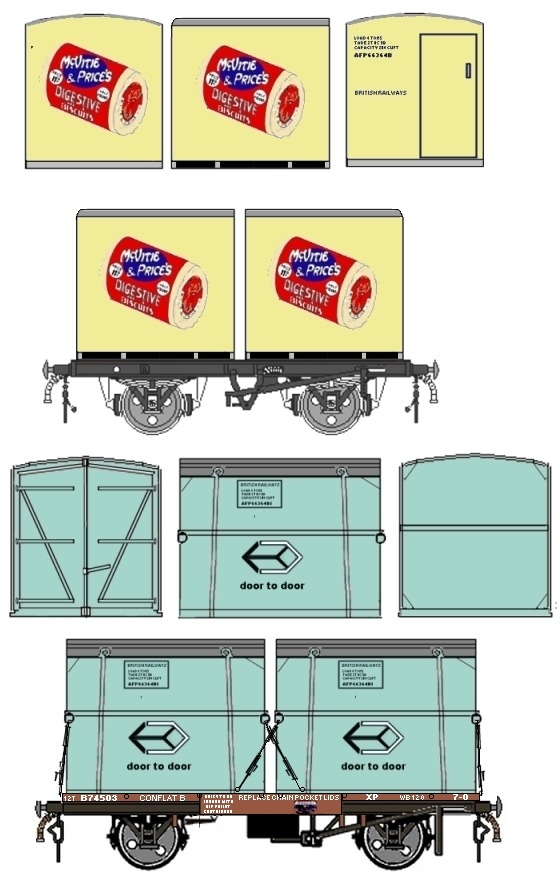
BR built at least one large insulated container, I believe
about thirty feet long, which could be carried on Rectank bogie wagons.
Developed for military tanks these wagons had a slightly lower central section
to the floor with short ramped sections at each end. This dropped floor was as
low as that on a Freightliner flat and allowed the large container to fit
within the loading gauge (as far as I am aware the later ISO standard boxes
were not moved on rectanks). The container itself appears to be made of
fibreglass laid on a timber frame, but I could be wrong on that. It had RCH
type roof mounted lifting rings but would require a gantry crane to move it and
so could only have operated between major towns.
Powder Containers
As well as wagon and van bodied containers there have been
various types of 'de-mountable tank' designs, used for carrying a wide range of
chemical liquids and powders such as flour and cement. British Railways coded
the containers for bulk materials in the L series and flour was carried in LF
type tank containers. Built in the late 1950's the LF containers lasted until
the early 1970's. Resembling tanks used for liquids and discharged by suction
they were carried on modified standard Conflat wagons. Something rather close
can be fettled using a Peco ten foot wheel base tank body with plasticard
details running on a standard Peco Conflat.
Fig ___ LF flour
container based on Peco tank
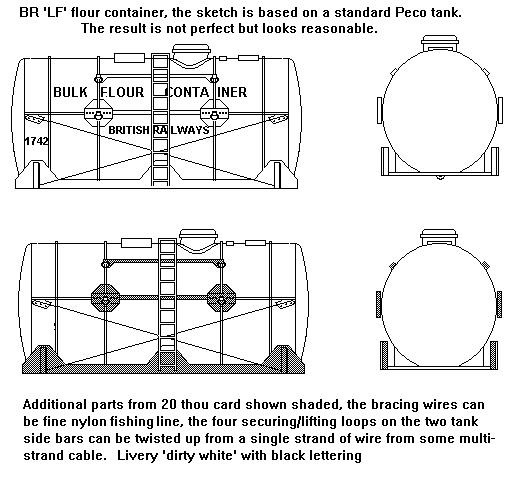
Powders proved to be a problem for bulk handling, they settled
in transit and even with vigorous banging on the sides the cargo often stayed
stubbornly inside. This problem was finally solved in the 1950's with the
introduction of air fluidisation, as used on the presflo and cemflo tank
wagons. Having said which BR produced the successful 'L' type container for
cement, these were rectangular boxes with ribbed sides. A large hatch on the
top was used for loading and they were discharged via a door in the bottom. I
have seen them mentioned as being used for 'limestone' traffic in the late
1970's but I cannot confirm if this is correct, lime would seem a more likely
cargo for them. They remained in use into the 1980's serving steel works and
carrying (I think) limestone.
Fig ___ Models of L type containers

The model shown was an early attempt, it lacks the top securing bars
and side discharge handle. These can be added using florists steel 'rose wire'.
A photo of a better model will be added later.
Wheeled Containers
BR introduced a number of small wheeled containers, the 'S' type was roughly a six foot cube with a canvass cover on top that was used for ferry traffic to Scottish islands. There is a photograph in Don Rowlands book on BR wagons (see bibliography) showing them loaded in pairs into drop-side medium steel bodied wagons but I do not know what routes they appeared on. The much more numerous SW type saw widespread use, after the Suez crisis of 1955-56 when oil prices rose dramatically BR had major problems acquiring enough of these to meet demand. I have not found any photographs showing these containers loaded into open wagons, they may have been shipped in vans, but collection and delivery appears to have favoured two containers roped down to a flat-bed semi trailer. A couple of these make handy set dressing in a busy goods yard scene.
Fig ___ SW type wheeled containers
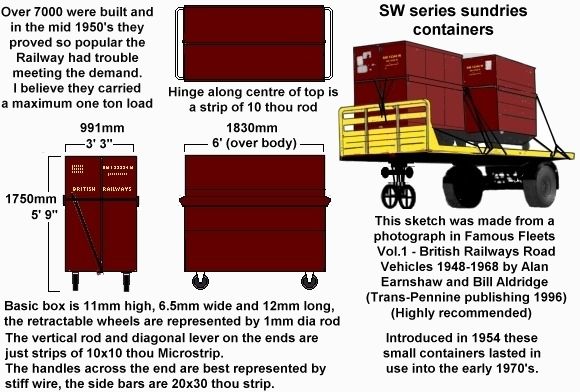
Speedfreight
Containers
In the 1961 London Midland Region introduced a new
container system, marketed as Speedfreight, initially for services between
London and Manchester (Speedfreight containers were later included in Condor
London to Glasgow service). Early Speedfreight containers resembled the pre-war
designs but they had recesses on the underside of the floor that engaged with
cone shaped mountings on the wagon. This eliminated the need to use chains and
turn buckles to secure the container to the wagon and speeded up the loading
and unloading operation. This meant they could not be handled using the
traditional goods yard cranes and could only run between specially equipped
depots. The cranes used for Speedfreight services are more fully discussed in
the section on Railway Company Goods Facilities - Container handling.
British Railways developed a number of light metal alloy designs specifically
for the Speedfreight service. These were all about seven foot wide and six and
a half foot high but the BA general merchandise type and the FA insulated type
were scaled to run on modified Conflat A wagons whilst the CA general
merchandise design was half again as long and was carried on a new type of
'Conflat P' wagon. As with the Condor Conflat P's these were based on the Peco
type plate wagon. The Speedfreight containers coded CA, BA and FA all had both
side and end doors. The shorter types (BA and FA) had a side doors which slid
to the rear to open. All had the Speedfreight lifting points on the base, at
nine foot separation and some CA and FA containers also had Freightliner
lifting points at twelve foot separation between centres. There were a small
number of eighteen foot long open containers built for Speedfreight services.
These were a plain metal ('five plank'sized) box fitted with four metal inverted U shaped hoops to support a tarpaulin (bringing the overall height to the Speedfrieght standard of 7ft 4.5 inches). I have only seen one photograph showing these, and it was only partly visible, so I was not able to attempt a sketch. The open containers were (I believe) designed to be lifted on and off the wagons by fork lift truck but as they were intended for Speedfreight services they presumably also had
Speedfreight lifting points. The only published reference I have found to these open containers is in Don Rowland's book British Railways Wagons where they are listed as type BO in the diagram lists.
Fig___ Speedfreight Containers
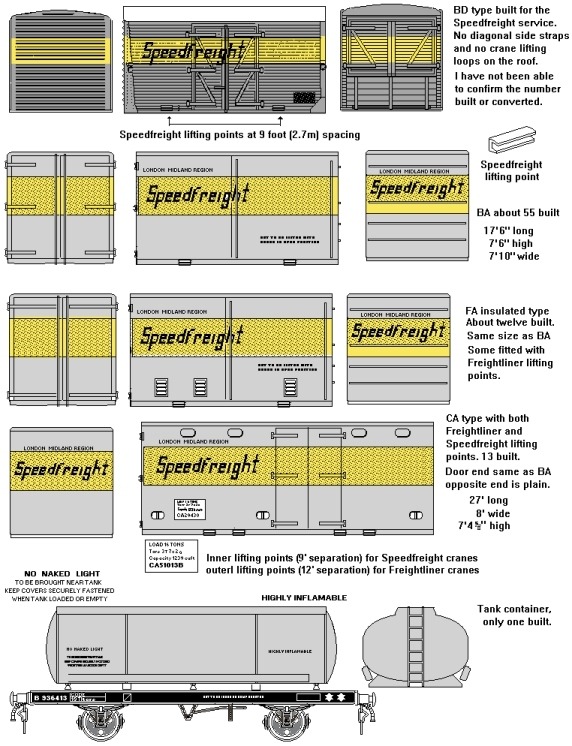
I had a lot of difficulty in finding details on Speefreight services, so I put up a question on the uk.railway newsgroup and Brian Williams was able to advise-
'Speedfreight' was the brand name used for
the bottom-lift containers, which extended to other terminals which used
either gantry cranes or large Lancer-Boss forklifts with grapples to handle
the containers. I'm pretty certain I remember seeing them at Swansea High St
(Goods) back in the early 1970s.
Regarding the wagons used- there were at least three types.
The first ones were Conflat As, which had the corners built up to locate the
containers.
These were followed by modified Plate VBs, which were fitted with secondary
springs to improve the ride. These were eventually retired, and again
modified to carry timber to the pulp mill at Corpach.
The final generation of wagons were modified Boplate Es, which lasted until
the mutation of Speedfreight into Freightliner- some of the larger
ex-Speedfreight boxes served with Freightliner in the pre-Twistlock and
toplift era. The Boplates went on serve as 'Conflat ISOs', carrying either
flat containers or low-sided ones, being too high to carry normal ISO boxes-
traffic for these include coil to Newport Docks and china clay from Par- the
very last of them saw out their days carrying potash and rock-salt
containers from Boulby.
Towards the end of 'conventional' container haulage, it was rare to see
ordinary Conflats, with most containers being carried in 5-plank opens. This
meant that they didn't need to be chained down, and also that the boxes
couldn't be opened in transit- this made them popular with the MoD, amongst
others.
The Boplate E wagons were numbered in the B94xxx series, they were 52 ft over headstocks, for use with containers the three-plank drop sides and planked floor were removed, revealing the metal framing underneath. I have also seen references to bogie conflats numbered in the B51xxxx series, I believe these were converted carriage underframes, if so they would be of the 57 ft variety.
By the later 1960's
the ISO standard container was starting to catch on world wide and this lead to
the development of the Freightliner service on British Railways. Later
Speedfreight containers, scaled to run on existing Conflat wagons, also had
secondary lifting points fitted to suit the lifting gear used by the early
Freightliner built containers (which also used grapple arm lifting gear). The
Speedfreight service was wound down and ceased operating in about 1971.
Paul Bartlett's rail wagon photographs website (see App 7 Useful
Links) contains photographs of various unusual or experimental container
designs.
In the mid 1960's the railways had owned nearly thirty two
thousand assorted containers, by the end of the 1970's there were only about
three hundred non Freightliner containers left on the books and it is doubtful
if any of the old RCH standard types, with their associated Conflat wagons,
were used after 1977 at the very latest (outlasting the newer Speedfreight
types). The only exception I know of being the L type as mentioned above.
^
Go to top of page
International Good Guys ~ Making the world a
better place since 1971 ~ Site maintained by

All material Copyright © Mike
Smith 2003 unless otherwise credited















